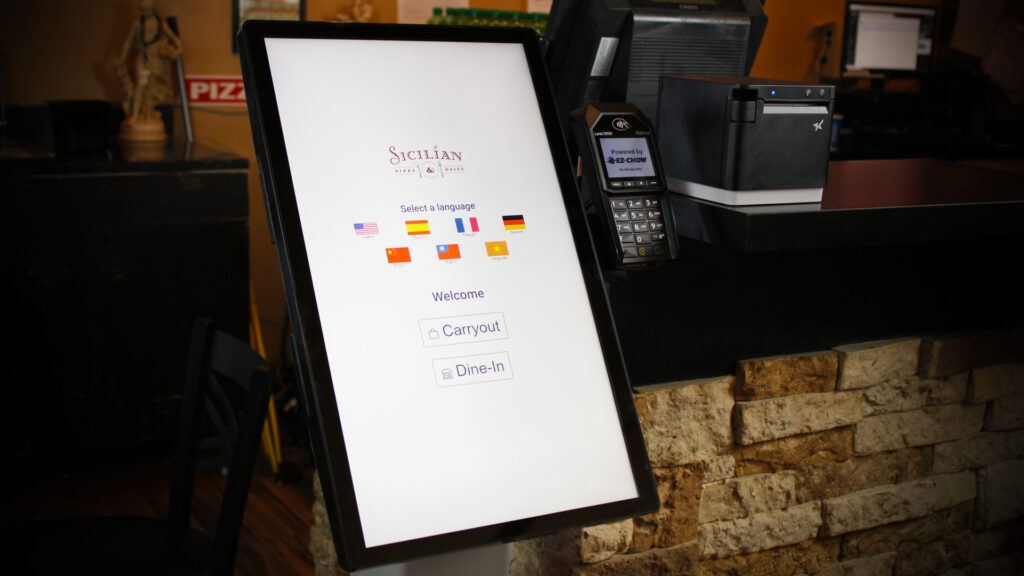Self-ordering kiosks have revolutionized the dining experience, offering a streamlined and efficient way for customers to place their orders. However, the cost of implementing self-ordering kiosks can be a significant investment for restaurants. In this comprehensive guide, we will explore 10 strategic approaches to reduce the cost of self-ordering kiosks without compromising on quality.
Let’s jump into one of our favorite topics.

Overview of Self-Service Kiosks
Before diving into cost-saving strategies, let’s start with a brief overview of what self-service kiosks are. Self-ordering kiosks are interactive devices that allow customers to browse menus, customize their orders, and make payments, all at their own pace. These high-tech, user-friendly devices have gained immense popularity in the restaurant industry, offering convenience and efficiency for both customers and restaurant owners.
Let’s explore 10 ways to reduce the cost of implementing these innovative devices.
- Strategic Procurement
When considering self-ordering kiosks, it’s important to engage in strategic procurement to get the best value for your investment. This involves researching different vendors, comparing prices, and evaluating their reputation and customer reviews. Look for vendors that offer competitive pricing without compromising on quality and reliability.
Additionally, consider the total cost of ownership, which includes not only the initial purchase cost but also factors such as maintenance, software updates, and technical support. By taking a holistic approach to procurement, you can ensure that you’re making a cost-effective choice without sacrificing the quality of the self-ordering kiosks.
- Bulk Purchases
Purchasing self-ordering kiosks in bulk can often lead to significant cost savings. When negotiating with vendors, inquire about bulk discounts or special pricing for multiple units. By consolidating your kiosk purchases into a single order, you can take advantage of economies of scale and reduce the overall cost per unit.
- Lifecycle Cost Analysis
To truly understand the cost implications of implementing self-ordering kiosks, it’s essential to conduct a lifecycle cost analysis. This involves evaluating not only the upfront purchase cost but also the long-term expenses associated with maintenance, repairs, and software updates.
Consider the projected lifespan of the kiosks, the frequency of required maintenance, and the availability of spare parts. By taking into account the complete lifecycle cost, you can make informed decisions and choose kiosks that provide the best value over time.
- Open-Source Software Integration
Opting for open-source software integration can significantly reduce the cost of self-ordering kiosks. Open-source solutions are often free to use and can be customized to meet your specific business needs. They offer flexibility and the ability to make changes without relying on a proprietary software provider.
However, it’s important to consider the technical expertise required to implement and maintain open-source software. If your team lacks the necessary skills, consider partnering with a technology provider that specializes in open-source solutions to ensure smooth integration and ongoing support.
- Energy-Efficient Hardware
Energy costs can be a significant expense for restaurants, especially those operating multiple self-ordering kiosks. To reduce energy consumption and lower operating costs, consider investing in energy-efficient hardware.
Look for kiosks that have energy-saving features such as LED displays, low-power processors, and power management systems. These energy-efficient kiosks not only help reduce electricity bills but also contribute to environmental sustainability.
- Regular Maintenance Protocols
Implementing regular maintenance protocols can help extend the lifespan of self-ordering kiosks and reduce repair costs. Develop a maintenance schedule that includes routine inspections, cleaning, and software updates.
Train your staff to perform basic maintenance tasks such as cleaning the touchscreens and checking for any physical damage. Additionally, establish a partnership with a reliable maintenance service provider who can handle more complex repairs and ensure that your kiosks are always in optimal working condition.
- Employee Training Programs
Investing in comprehensive employee training programs can help reduce costs associated with user errors and operational inefficiencies. Properly trained employees will be more adept at using and troubleshooting self-ordering kiosks, minimizing the risk of technical issues and customer dissatisfaction.
Develop training modules that cover the basics of operating the kiosks, troubleshooting common problems, and ensuring data security. Ongoing training sessions and refresher courses can also help keep your staff up to date with the latest software updates and best practices.
- Cloud-Based Solutions
Opting for cloud-based solutions can offer significant cost savings compared to traditional on-premises infrastructure. Cloud-based self-ordering kiosk systems eliminate the need for expensive hardware and maintenance, as everything is managed and stored in the cloud.
With a cloud-based solution, you can also benefit from automatic software updates and scalability, allowing you to easily add or remove kiosks as your business needs evolve. Additionally, cloud-based systems often offer robust data analytics and reporting capabilities, enabling you to make data-driven decisions to optimize your operations.
- Strategic Location Planning
Strategic location planning is crucial when deploying self-ordering kiosks. By carefully analyzing customer flow, foot traffic, and peak dining hours, you can determine the optimal placement of kiosks to maximize their usage and revenue potential.
Consider factors such as visibility, accessibility, and convenience for customers. Placing self-ordering kiosks near entranceways, busy areas, or near the queue line can encourage customers to use them and reduce wait times at traditional ordering points.
- Vendor Partnerships
Partnering with a reliable and experienced vendor can offer numerous cost-saving benefits. Look for vendors that offer comprehensive solutions, including hardware, software, maintenance, and support.
One such vendor is EZ-Chow, a leading provider of self-ordering kiosk solutions. They offer end-to-end services, from procurement and installation to ongoing maintenance and support. By partnering with EZ-Chow, you can leverage their expertise and benefit from their vendor partnerships to reduce the overall cost of implementing self-ordering kiosks.
Why Partner with EZ-Chow
EZ-Chow is a trusted partner for restaurants looking to implement cost-effective self-ordering kiosk solutions. With our extensive industry experience and comprehensive services, we can help you navigate the complexities of kiosk procurement, installation, maintenance, and support.
Our strategic vendor partnerships and commitment to customer satisfaction ensure that you’ll receive high-quality, reliable self-ordering kiosks that meet your unique business requirements. By partnering with EZ-Chow, you can reduce costs, increase efficiency, and enhance the overall dining experience for your customers.
Summing Up
Implementing self-ordering kiosks can be a game-changer for restaurants, offering numerous benefits such as improved efficiency, reduced labor costs, and increased customer satisfaction. By following these 10 cost-saving strategies and partnering with a reliable vendor like EZ-Chow, you can minimize the financial burden of implementing self-ordering kiosks while maximizing the return on your investment.
Take the leap into the future of dining and embrace the power of self-ordering kiosks. With the right cost-saving strategies and a trusted partner by your side, you can enhance your operations, boost revenue, and provide an exceptional dining experience for your customers. Contact EZ-Chow today to explore how their self-ordering kiosk solutions can transform your restaurant.
—————————————————
Author

Marketing,Branding & e-Commerce -Consultant
Click to learn more about Bernie Fussenegger


